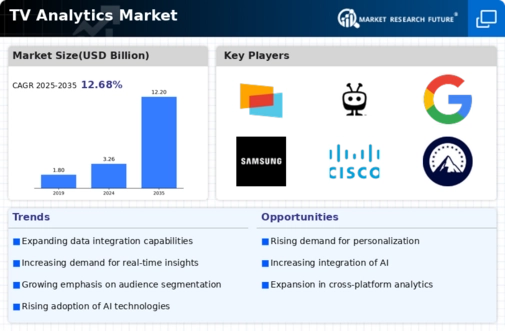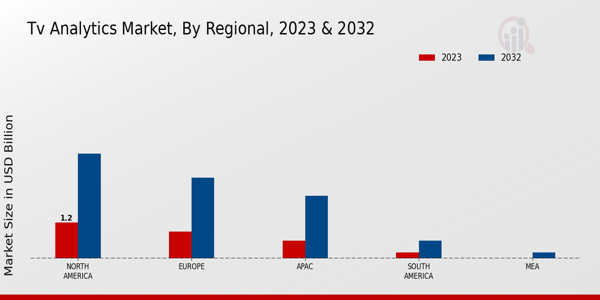Market Growth Projections
The Global TV Analytics Market Industry is poised for substantial growth, with projections indicating a rise from 3.26 USD Billion in 2024 to 12.2 USD Billion by 2035. This growth trajectory suggests a compound annual growth rate of 12.72% from 2025 to 2035, reflecting the increasing reliance on analytics in the television sector. The market's expansion is driven by the rising demand for data-driven insights, technological advancements, and the shift towards streaming services. These factors collectively indicate a robust future for the industry, underscoring the critical role of analytics in shaping the television landscape.
Shift Towards Streaming Services
The shift towards streaming services is a pivotal driver in the Global TV Analytics Market Industry. As traditional television viewership declines, streaming platforms are gaining prominence, necessitating advanced analytics to understand audience dynamics. Streaming services utilize analytics to tailor content recommendations and advertising strategies, enhancing user satisfaction and retention. This transition is likely to accelerate market growth, as streaming platforms invest in analytics to optimize their offerings. The increasing number of subscribers to these platforms further underscores the importance of analytics in navigating this competitive landscape.
Rising Demand for Data-Driven Insights
The Global TV Analytics Market Industry is experiencing a notable surge in demand for data-driven insights. As advertisers and content creators increasingly seek to understand viewer preferences and behaviors, analytics tools become essential. In 2024, the market is projected to reach 3.26 USD Billion, driven by the need for precise targeting and improved return on investment. Companies are leveraging analytics to optimize content delivery and enhance viewer engagement. This trend is likely to continue, as the industry evolves towards more personalized viewing experiences, suggesting a robust growth trajectory in the coming years.
Regulatory Changes and Compliance Needs
Regulatory changes and compliance needs are influencing the Global TV Analytics Market Industry. As governments implement stricter data privacy regulations, companies must adapt their analytics practices to ensure compliance. This shift necessitates the development of analytics tools that prioritize data security while still delivering actionable insights. The evolving regulatory landscape may drive innovation in analytics solutions, as organizations seek to balance compliance with the need for effective audience engagement strategies. This dynamic environment presents both challenges and opportunities for growth within the market.
Growing Importance of Audience Measurement
Audience measurement is becoming increasingly critical in the Global TV Analytics Market Industry. Accurate measurement of viewer engagement and demographics is essential for advertisers seeking to maximize their impact. The demand for reliable audience metrics is driving the adoption of advanced analytics solutions, enabling broadcasters and advertisers to make informed decisions. As the market evolves, the need for comprehensive audience insights is expected to grow, potentially leading to a compound annual growth rate of 12.72% from 2025 to 2035. This trend highlights the necessity of robust analytics in understanding viewer preferences.
Technological Advancements in Analytics Tools
Technological advancements are significantly shaping the Global TV Analytics Market Industry. Innovations in artificial intelligence and machine learning are enhancing the capabilities of analytics tools, allowing for deeper insights into viewer behavior. These technologies enable real-time data processing, which is crucial for timely decision-making in content creation and advertising strategies. As a result, the market is expected to grow substantially, with projections indicating a rise to 12.2 USD Billion by 2035. This growth reflects the increasing reliance on sophisticated analytics solutions to drive competitive advantage in the rapidly evolving media landscape.
























